Holiday World – Santa Claus, Indiana
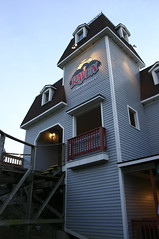 Ride progression does not seem to be something that’s often in the collective consciousness of the mainstream enthusiast community. However, if there is a roller coaster that’s universally famous for having strong progression, it’s probably the Raven. The only other coaster I can think of that uses progression as powerfully as the Raven is Kennywood’s Thunderbolt; not coincidentally, both of these coasters were at one time ranked as #1 in the world, at times when there seemed to be bigger and better contenders for the title but there was something about these rides that just made them special enough to hold that number one spot. While I’m sure there’s as many reasons unique reasons for loving these rides as there are people that love them, I would argue that the underlying progression in their layouts is the biggest factor in their lasting appeal.
Ride progression does not seem to be something that’s often in the collective consciousness of the mainstream enthusiast community. However, if there is a roller coaster that’s universally famous for having strong progression, it’s probably the Raven. The only other coaster I can think of that uses progression as powerfully as the Raven is Kennywood’s Thunderbolt; not coincidentally, both of these coasters were at one time ranked as #1 in the world, at times when there seemed to be bigger and better contenders for the title but there was something about these rides that just made them special enough to hold that number one spot. While I’m sure there’s as many reasons unique reasons for loving these rides as there are people that love them, I would argue that the underlying progression in their layouts is the biggest factor in their lasting appeal.
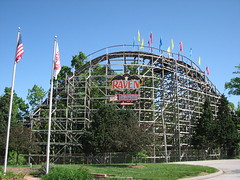 Before moving on, a quick defining of terms, just in case you’ve been wondering what the heck I’m talking about and why I’m not discussing the Raven’s airtime or use of terrain instead. When I look at a coaster’s progression, I’m looking at how the experience manages to evolve over the course of the layout; how it “tells a story”, which I think is the most popular way of putting it when progression is discussed amongst enthusiasts. I’d generally like to stay away from that term, since “telling a story” implies narrative and those rules of structuring and so on, all of which is a slightly different category of aesthetics than what I think we’re looking at in the coaster realm.
Before moving on, a quick defining of terms, just in case you’ve been wondering what the heck I’m talking about and why I’m not discussing the Raven’s airtime or use of terrain instead. When I look at a coaster’s progression, I’m looking at how the experience manages to evolve over the course of the layout; how it “tells a story”, which I think is the most popular way of putting it when progression is discussed amongst enthusiasts. I’d generally like to stay away from that term, since “telling a story” implies narrative and those rules of structuring and so on, all of which is a slightly different category of aesthetics than what I think we’re looking at in the coaster realm.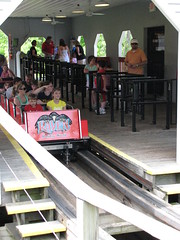
The most common form of progression is natural to nearly all coasters, and that’s the tightening of a ride’s pace, timing and rhythm as the elements become smaller throughout the ride due to the loss of speed from friction. Some rides manage this form of progression very well, others just get more boring as the ride goes on, but with few exceptions, all traditional forms of coaster design are bound by this rule.
Another example of common forms of progression is what I’d call the two-part or three-part ride form (not many coasters go higher than that). Denver’s Lakeside Cyclone contains an example of the two-part ride structure in its most simplified form. The coaster begins as a twister layout, and then midway through it switches to an out-and-back. There’s not much more subtlety to the ride experience than that, and psychologically I’m fairly certain that simply changing from one style to another doesn’t accomplish much (that ride has a million other charms regardless to make it one of my favorites), but the simple nature of the progression is indisputably there. 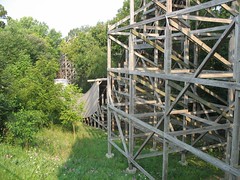 More complex forms of progression exist in rides that use tightly structured patterns to organize what’s normally coaster chaos, perhaps at first reiterating a simple theme, then from that creating a brand new theme, and finally returning to the original theme but expressed in an altered form. (Read my Fahrenheit analysis for an example of this)
More complex forms of progression exist in rides that use tightly structured patterns to organize what’s normally coaster chaos, perhaps at first reiterating a simple theme, then from that creating a brand new theme, and finally returning to the original theme but expressed in an altered form. (Read my Fahrenheit analysis for an example of this)
The Raven uses a two-part progression pattern. To put it simply, the first half features a more classicalist segmentation of up-and-down hills and curves, the second half is the ground level flight through the woods. There are many more distinguishing characteristics that make this progression more advanced than simply stitching two separate halves together (not least of which is the pivotal role played by the famous fifth drop, but we’ll get to that later…) What I find most impressive about the Raven is that it’s able to contain a fully-realized example of progression despite being a very short ride. It made it through ten years of operation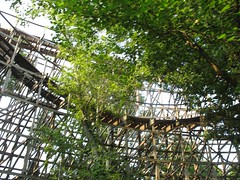 with only one train before the second was added in 2005 and for the most part it handled crowds adequately with just that load; it only takes about 45 seconds for the train to go from the crest of the first drop to the brakes, and yet in that time frame it manages to complete an entire narrative arc… although as I said earlier narrative analogies to a ride’s progression I don’t think hold up very well once you start analyzing it very deep; perhaps an arpeggio or movements in music composition are better analogies? (And to put the ride’s size in proper perspective, while it may appear diminutive compared to the Voyage it’s actually the same as the average GCI creation: SFMM’s recent Terminator Salvation coaster only racks up 77ft. more track on a single run compared to the Raven’s 2800ft. long layout)
with only one train before the second was added in 2005 and for the most part it handled crowds adequately with just that load; it only takes about 45 seconds for the train to go from the crest of the first drop to the brakes, and yet in that time frame it manages to complete an entire narrative arc… although as I said earlier narrative analogies to a ride’s progression I don’t think hold up very well once you start analyzing it very deep; perhaps an arpeggio or movements in music composition are better analogies? (And to put the ride’s size in proper perspective, while it may appear diminutive compared to the Voyage it’s actually the same as the average GCI creation: SFMM’s recent Terminator Salvation coaster only racks up 77ft. more track on a single run compared to the Raven’s 2800ft. long layout)
This is all starting to read as being a bit too single-minded, what else is there to appreciate about the Raven? The setting for one, the airtime for another; read any other review of the ride and you’re likely to encounter a good deal of superlatives about each of these elements, so I won’t dwell too much on either of these aspects before starting the play-by-play ride description. I will say that on my last visit, neither of these elements were true stand-outs in defining the Raven against other coasters.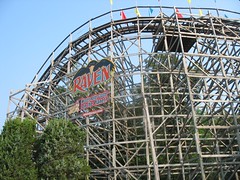
The airtime is there and I can see how longtime friends of the Raven will appreciate it, but a word to any potential newcomers to the Raven experience: know that the airtime probably won’t strike you as the first, or even the second or third things that stand out in the ride. There’s the first drop air, which like any first drop can only be experienced in the back of the train. There’s a bit of air over the next hill or two depending on if you’re getting it at the end of a hot summer day or at the beginning of a warm, early season morning (as I did). And then there’s fifth drop air, which officially is considered to be “legendary” although I’ve heard reports from many others saying they didn’t find much of any uplift. Me, I must confess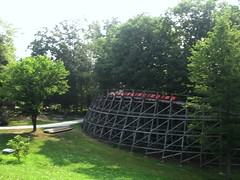 I didn’t pay much attention to if there was or wasn’t, I was more interested in other things going on, such as the use of terrain.
I didn’t pay much attention to if there was or wasn’t, I was more interested in other things going on, such as the use of terrain.
The old story goes that Holiday World owner Will Koch was so invested in saving as many trees in the park as possible that sections of the coaster underwent last-minute design changes in order to save a few extra tree (that’s what’s responsible for the little s-curve zigzag at the very bottom of the fifth drop). Which is interesting because the last time I rode the Raven all I noticed was a huge parking lot on the out run and a huge cleared field on the final ‘terrain’ portion of the run. It only seemed to enter the woods for just a split second after both the fifth drop and just before the brakes, but the wide right turn that makes up about half the trackwork in the second half of the ride has nothing but grass and weeds off to the left side of it. Looking over some older videos I noticed that was always part of the land since it first opened, but it felt very noticeable on this most recent visit.
of the ride has nothing but grass and weeds off to the left side of it. Looking over some older videos I noticed that was always part of the land since it first opened, but it felt very noticeable on this most recent visit.
But then there’s the ride at night. Because the park generally doesn’t keep late hours I’ve only ever had the pleasure to ride the Raven after dark on two occasions, once in 2000 and again in 2006. Both times were magnificent experiences. Provided there aren’t too many lights from the parking lot seeping into the area (which is why I should probably think about attending a Holiwood Nights event one of these years) once the train crests the lift until it returns to the station house, you are suffocated by complete and total darkness. Will Koch stated his inspiration for building the Raven was to make a small scale versions of the Beast; while many enthusiasts believe the Raven far exceeds the Beast by virtue that the Raven actually does stuff, the one regard that does see the Raven stand as equal peers with the Beast is in how they are completely transformed by the nighttime setting. As I write these words and reflect further on those two after dark rides I’ve had, I’ve realized just how much higher I should make it a priority to get to Holiwood Nights because I’ve had the Raven sitting comfortably in my top ten mostly by the virtue of its daytime rides, I can’t imagine what it might be if I could savor it through repeated night rides with the lights flooding the parking lot turned off.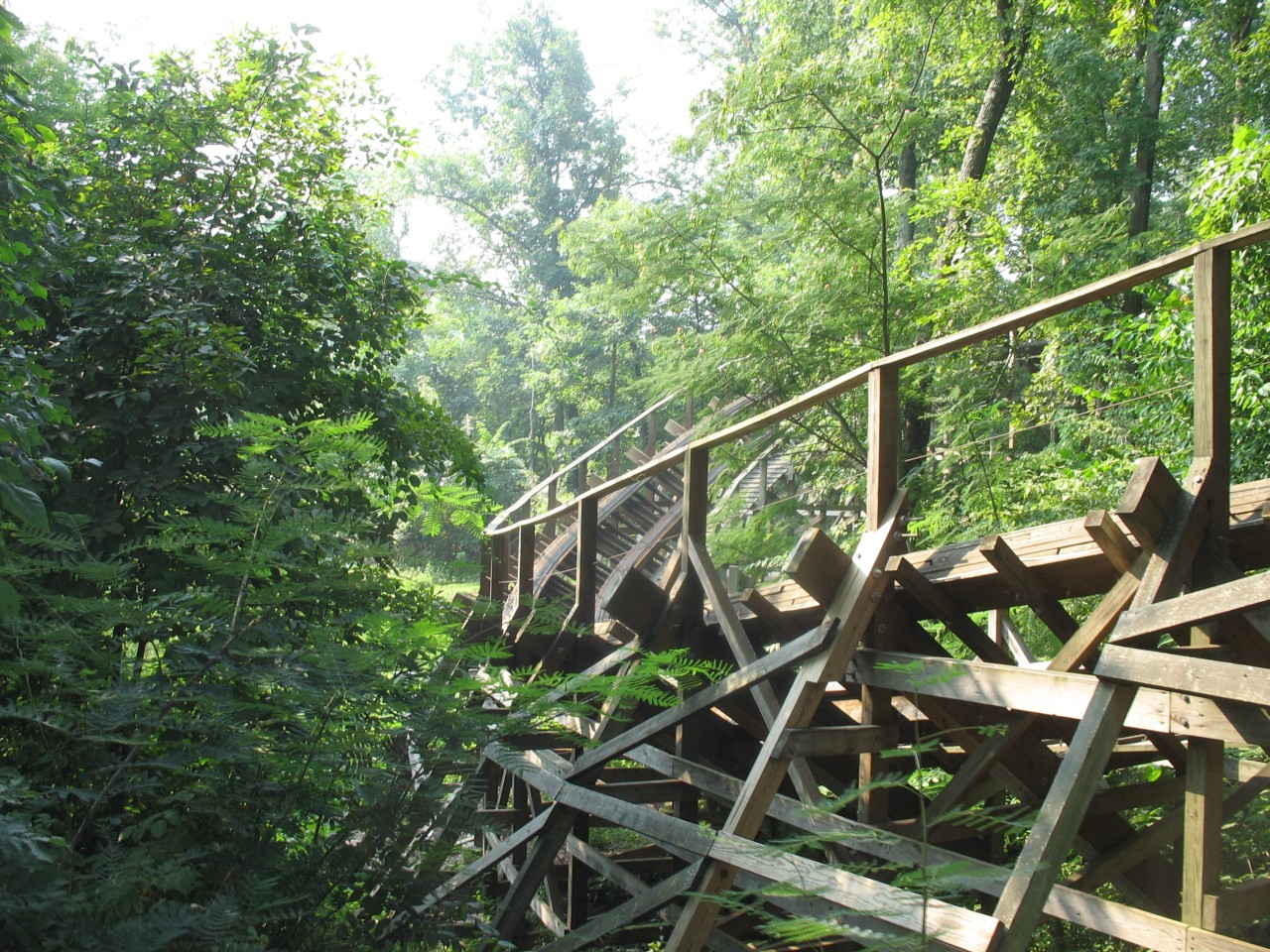
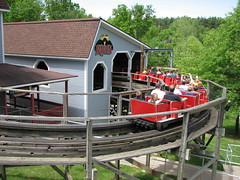 The Raven begins in much the same way as the Beast, by giving us an ample amount of time to think about the ride we have ahead of us; also like the Beast, not much of the Raven besides the lift can be seen from inside the park, although depending on where you parked your car you might pass by quite a bit of it on the tram into the park. We slowly make a tight left turn out of the station and over the queue, rumbling through the transfer shed that’s run parallel to the station since it was added in 2005 to accommodate a second train, before there’s a quick left dive under the returning brake run and engaging the lift. The lift climbs up the side of a well-forested hill, and if you look to the right you can catch a unique perspective of the forested s-turn final, the geographical nearness yet appearance of greater distance highlighting
The Raven begins in much the same way as the Beast, by giving us an ample amount of time to think about the ride we have ahead of us; also like the Beast, not much of the Raven besides the lift can be seen from inside the park, although depending on where you parked your car you might pass by quite a bit of it on the tram into the park. We slowly make a tight left turn out of the station and over the queue, rumbling through the transfer shed that’s run parallel to the station since it was added in 2005 to accommodate a second train, before there’s a quick left dive under the returning brake run and engaging the lift. The lift climbs up the side of a well-forested hill, and if you look to the right you can catch a unique perspective of the forested s-turn final, the geographical nearness yet appearance of greater distance highlighting  just how far down the terrain difference is for that final portion of the ride; the first drop is only 85 feet and yet the total height difference yields about 35% more vertical distance with this finale.
just how far down the terrain difference is for that final portion of the ride; the first drop is only 85 feet and yet the total height difference yields about 35% more vertical distance with this finale.
We crest the lift overlooking the Holiday World parking lot and make a small pivot to the right before angling down the first drop. CCI’s method of profiling a hill such as on the Raven can easily be contrasted with the newer, “improved” method seen by the Gravity Group on the other side of the park: the curvature to the maximum steepness is very tight, and most of the drop consists of perfectly flat track until the pullout. While in theory the approach seen by the Voyage should produce greater amounts of airtime because the outward curvature produces both 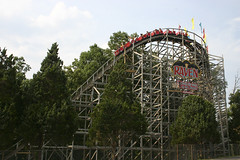 centrifugal forces that translate into airtime for the rider that a flat downward slope such as the Raven’s is unable to achieve,
centrifugal forces that translate into airtime for the rider that a flat downward slope such as the Raven’s is unable to achieve, in practice the tight pullover contributes to far more intense ejector forces which are able to be sustained by the gravitational acceleration downhill; if you compare the two approaches to first drop profiling side-by-side, the reason the Raven is able to produce the stronger forces is that it fits that same pullover in 1/4 the space.
in practice the tight pullover contributes to far more intense ejector forces which are able to be sustained by the gravitational acceleration downhill; if you compare the two approaches to first drop profiling side-by-side, the reason the Raven is able to produce the stronger forces is that it fits that same pullover in 1/4 the space.
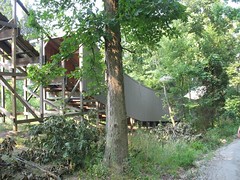 We pull out and into the tunnel. Despite appearances this flat stretch of tunnel is actually angled slightly downhill, so not only is the high rate of speed contrasted with the acoustic reverberations and fast parallax with the walls sustained for a moment before pulling back up into the clear air, but the speed actually continues to push forward even more so the maximum speed on the ride is achieved just before the exit. The next hill isn’t one I ever attribute as being particularly forceful, but it’s a good exercise in sustaining speed over the entire rise and fall, the slight righthand turn at the top making for a harsh little interlude between the
We pull out and into the tunnel. Despite appearances this flat stretch of tunnel is actually angled slightly downhill, so not only is the high rate of speed contrasted with the acoustic reverberations and fast parallax with the walls sustained for a moment before pulling back up into the clear air, but the speed actually continues to push forward even more so the maximum speed on the ride is achieved just before the exit. The next hill isn’t one I ever attribute as being particularly forceful, but it’s a good exercise in sustaining speed over the entire rise and fall, the slight righthand turn at the top making for a harsh little interlude between the graceful airiness on either side of the pullover. We dive down and back up once more over a gradual, rounded little hill, the lake coming into sight as we pull over the top of this slightly airy crest.
graceful airiness on either side of the pullover. We dive down and back up once more over a gradual, rounded little hill, the lake coming into sight as we pull over the top of this slightly airy crest.
This leads directly into the turn over Lake Rudolph, done with a typical CCI-styled swoop at either end as it curves close to the water, slowing down the timing between elements while maintaining the strong rate of speed as mildly persistent laterals are thrown into the mix for the first time in the ride. Instead of transitioning back into a set of more tightly paced hills, the train continues to sweep back up towards the direction it originally came, starting to sacrifice some of the sustained speed and pacing before the wide elevated turn to the left matches up 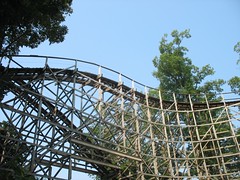 alongside the second hill. Many of CCI’s later designs would continue to include this moment (normally after a midpoint in the ride such as a turnaround) that momentarily curbs the generated excitement before it kicks back in with another steep drop into more of the same high-level pacing. In the Raven’s case, instead of diving down the only thing that drops off is the excitement level even more as there is only a small dip (no forces) set next to the second hill structure as it turns back away from the outward bound track again to face into the woods, rising a second time to the loss of most of the trains energy.
alongside the second hill. Many of CCI’s later designs would continue to include this moment (normally after a midpoint in the ride such as a turnaround) that momentarily curbs the generated excitement before it kicks back in with another steep drop into more of the same high-level pacing. In the Raven’s case, instead of diving down the only thing that drops off is the excitement level even more as there is only a small dip (no forces) set next to the second hill structure as it turns back away from the outward bound track again to face into the woods, rising a second time to the loss of most of the trains energy.
Think of one of your favorite coasters, and then think of that singular moment along the course of the ride that best captures the reasons why you love it, the moment that always causes a 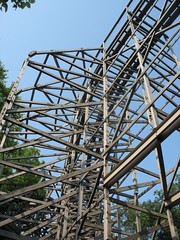 mental snap of the fingers when you realize “now this is why this coaster will always be better than the rest!” For me, that moment on the Raven isn’t getting hit with the sharp ejector into the first drop nor is it that tricky little s-curve at the bottom of the fifth drop. Nor is it the fifth drop itself, which would appear to be the next element I ought to cover in this progression analysis of the ride. It’s a flat stretch of track about three feet long that separates the small curved rise after the fourth small dip, and the sharp plunge down into the 61ft. tall fifth drop. It probably isn’t even intentional, probably this was intended to be a continuously curved crest, but the apex would have been in the open air between ledgers so it just flattened out from point A ledger to point B ledger instead. But this singular moment is where the progression factor I praise so dearly about the Raven is not simply some abstract concept you have to think about over the course of the ride, but right there, in the moment, sitting in front of you. It’s just a lull by itself, so you’re not thinking about the ride in the moment but instead of where you just came from (a diminuendo in pacing after a ‘traditional’ coaster experience) and what’s immediately to come.
mental snap of the fingers when you realize “now this is why this coaster will always be better than the rest!” For me, that moment on the Raven isn’t getting hit with the sharp ejector into the first drop nor is it that tricky little s-curve at the bottom of the fifth drop. Nor is it the fifth drop itself, which would appear to be the next element I ought to cover in this progression analysis of the ride. It’s a flat stretch of track about three feet long that separates the small curved rise after the fourth small dip, and the sharp plunge down into the 61ft. tall fifth drop. It probably isn’t even intentional, probably this was intended to be a continuously curved crest, but the apex would have been in the open air between ledgers so it just flattened out from point A ledger to point B ledger instead. But this singular moment is where the progression factor I praise so dearly about the Raven is not simply some abstract concept you have to think about over the course of the ride, but right there, in the moment, sitting in front of you. It’s just a lull by itself, so you’re not thinking about the ride in the moment but instead of where you just came from (a diminuendo in pacing after a ‘traditional’ coaster experience) and what’s immediately to come.
A 61 foot drop not much gentler than the first, down the hillside and into the cavern of trees. Lots of coasters out there use lulls followed by big moments, but none have ever been nearly as effective as on the Raven, at least relative to the original context of the ride. This drop effectively reboots the coaster anew, tossing away the classical hills and curves approach used by the first half and changing into something never really seen before or since in the history of coasters. We pull out hard at the bottom and quickly dodge to the right, the left. From here to the end the train relentlessly powers ahead at full speed, never experiencing more than a 20 ft elevation change so that there is no loss in forward momentum. Just the pacing by itself would make this section unique, forgoing the fast-slow-fast-slow pattern found on most coasters including this one for the first half and instead keeping it perfectly consistent all the way until the brakes. I always found it odd that the Raven was championed for being an airtime lover’s coaster when the best part about the ride was just sustained ground level speed and laterals. We make a long transition anticipating the wide righthand turn, it hitting hard and sustaining the g-forces for what feels like twice as long and as strong as the previous lake turn. Sit in the back row and watch the cars arrange themselves in a fixed arc as they navigate the curve, the only movement being the shuffling back and forth and the rapidly shifting mosaic of greenery in the background, indicative of both our precarious velocity changing through the woods and the complete control the Raven has over its flight path. The ride shifts back upward, scooting over a small crest before diving back down to the left, touching close enough to the ground we can count the individual ferns as they whiz by. The track curves upward to be greeted with the brake run. The ride may not last long but it hardly seems like it when it’s actually over.
momentum. Just the pacing by itself would make this section unique, forgoing the fast-slow-fast-slow pattern found on most coasters including this one for the first half and instead keeping it perfectly consistent all the way until the brakes. I always found it odd that the Raven was championed for being an airtime lover’s coaster when the best part about the ride was just sustained ground level speed and laterals. We make a long transition anticipating the wide righthand turn, it hitting hard and sustaining the g-forces for what feels like twice as long and as strong as the previous lake turn. Sit in the back row and watch the cars arrange themselves in a fixed arc as they navigate the curve, the only movement being the shuffling back and forth and the rapidly shifting mosaic of greenery in the background, indicative of both our precarious velocity changing through the woods and the complete control the Raven has over its flight path. The ride shifts back upward, scooting over a small crest before diving back down to the left, touching close enough to the ground we can count the individual ferns as they whiz by. The track curves upward to be greeted with the brake run. The ride may not last long but it hardly seems like it when it’s actually over.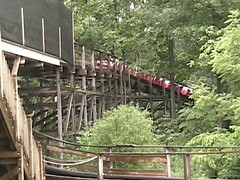
In summation, my thesis for the Raven is that the coaster’s success is mostly accredited not simply to the airtime in the first half or the terrain use in the second, but from the way it progresses from the first half to the disparate yet complementary second, with the diminuendo/pause/fifth drop being an effective bridge between the two. While hopefully anyone that’s familiar with the Raven can easily see that it progresses in this fashion (because this is a fact anyone can obtain just from looking at the POV video), it might not be immediately clear that the concept of progression in a coaster makes any impact in its effectiveness. One might object that while things like progression can be nice extras in a ride and can be interesting to speculate about 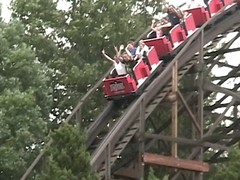 online during the offseason, when it comes down to it all that people respond to are more physical, tactile dimensions such as the amount of airtime or great night rides. We might even be able to take this further and state that it’s impossible for anyone to derive any additional satisfaction from a decent progression structure; what we really are responding isn’t the progression but the fact that we get a wider variety of experiences in a single ride, and any coaster that includes this variety will therefore also have ‘progression’ as it switches from one experience to the next. In other words, progression isn’t a contributing factor to a coaster’s success, but merely a necessary condition that always corresponds to this other factor of diversity of elements which is what actually makes a coaster great.
online during the offseason, when it comes down to it all that people respond to are more physical, tactile dimensions such as the amount of airtime or great night rides. We might even be able to take this further and state that it’s impossible for anyone to derive any additional satisfaction from a decent progression structure; what we really are responding isn’t the progression but the fact that we get a wider variety of experiences in a single ride, and any coaster that includes this variety will therefore also have ‘progression’ as it switches from one experience to the next. In other words, progression isn’t a contributing factor to a coaster’s success, but merely a necessary condition that always corresponds to this other factor of diversity of elements which is what actually makes a coaster great.
To answer these objections, I will first concede that, yes, you can’t make anyone appreciate progression in a ride, each person’s brain responds to different stimuli (either through genetics, historical conditioning or underlying beliefs and bias) and for some people things like progression might never cross their subconscious let alone their conscious. And that’s perfectly okay, it’s not their fault. Some people also enjoy movies such as Transformers 2 or G.I. Joe and believe that the radio top 40 refers to the musical quality, and living in a modern society we should recognize that all of these preferences are completely subjective to each individual and every opinion is just as valid as the next…
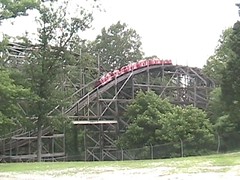 More seriously, I think if there is any debate to be had on whether these more intangible principles such as progression ought to have a place in roller coaster aesthetic theory, allegiances will be formed with strong correlation to whether or not one’s underlying attitude towards coasters is more passive and treats it as a sensational-input device (i.e. “All I want is to maximize the quantity of airtime or other sensations I find pleasurable”) versus those that take a more active, intellectual approach to rides where psychology can be more important than physics (i.e. “What am I thinking during the ride, how does it play with my expectations and then change the outcome, is this a layout I can admire from a designer’s perspective?”) To defend the later position, I will note that this position (that the coaster is something thought about rather than just experienced) is pretty much the standard for all other art forms… theater, music, cinema, visual arts, even culinary arts…
More seriously, I think if there is any debate to be had on whether these more intangible principles such as progression ought to have a place in roller coaster aesthetic theory, allegiances will be formed with strong correlation to whether or not one’s underlying attitude towards coasters is more passive and treats it as a sensational-input device (i.e. “All I want is to maximize the quantity of airtime or other sensations I find pleasurable”) versus those that take a more active, intellectual approach to rides where psychology can be more important than physics (i.e. “What am I thinking during the ride, how does it play with my expectations and then change the outcome, is this a layout I can admire from a designer’s perspective?”) To defend the later position, I will note that this position (that the coaster is something thought about rather than just experienced) is pretty much the standard for all other art forms… theater, music, cinema, visual arts, even culinary arts…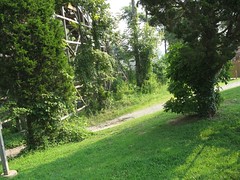 coasters borrow many of the same aesthetic principles as these mediums, and yet I frequently get the sense that many people think the only part of the body they ought to affect is the adrenal gland. And that’s by no means saying that progression by itself is a sufficient cause for a great ride; if the airtime in the first half was weak or the forest missing from the second half of the Raven, then the ride would suck no matter how it’s arranged. However, I think progression is one of the best ways to start looking at and appreciating a coaster beyond instantaneous sensory feedback, and the psychological effects of a good progression structure are very real, compared to a coaster that could be said to have progression but only highlights its weaknesses by concentrating the dull sections at the end instead of using them to set up an exciting moment.
coasters borrow many of the same aesthetic principles as these mediums, and yet I frequently get the sense that many people think the only part of the body they ought to affect is the adrenal gland. And that’s by no means saying that progression by itself is a sufficient cause for a great ride; if the airtime in the first half was weak or the forest missing from the second half of the Raven, then the ride would suck no matter how it’s arranged. However, I think progression is one of the best ways to start looking at and appreciating a coaster beyond instantaneous sensory feedback, and the psychological effects of a good progression structure are very real, compared to a coaster that could be said to have progression but only highlights its weaknesses by concentrating the dull sections at the end instead of using them to set up an exciting moment.
Or maybe I’m reading popular opinion all wrong and most fans of the Raven already agree with me about the role of progression (differences in opinions about the specific details are always encouraged, however). What do you think? Why is the Raven so popular despite being such a small coaster? Or, alternatively, why is it overrated and the weakest of the three wooden coasters in the park? Anyone that can write their reply in the form of an Edgar Allen Poe styled poem will be awarded two free internets.
(Additional photo credits to Anthony Harrison and Freddie Ross. Used with permission.)


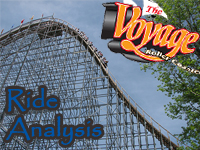
Comments